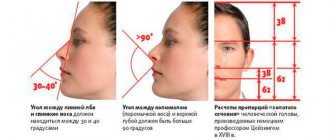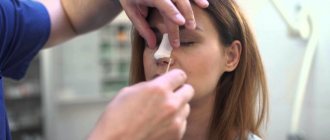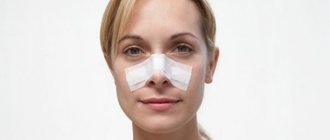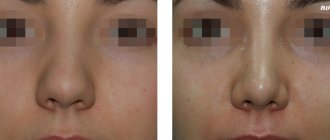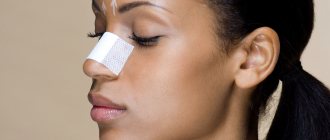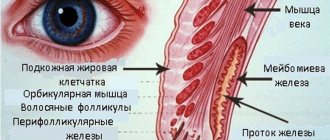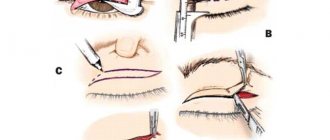Nasal tip rhinoplasty is a frequently requested correction. This is the central part of the face and all geometry and perception of appearance depends on it.
Nature has endowed each person with different external characteristics. The tips of the nose also differ: they range from upturned and thin, narrow and wide to voluminous and drooping. And it often happens that the nasal design does not satisfy the owner.
This is where plastic surgery comes to the rescue. What are the options for correcting the deficiency?
What is nasal tip rhinoplasty?
Rhinoplasty of the tip of the nose is a surgical method for correcting this area and is the most popular rhinoplasty operation.
There are several common factors that can create a rounded nose tip (or potato nose).
- Patients with thicker skin on the nose often experience a more rounded tip. In this case, you can remove excess tissue.
- The second reason is the cartilage itself. The lower and lateral cartilages may be too wide or convex.
The operation will correct the tip of the nose:
- rounded - will reduce;
- lowered - will raise;
- crooked - straightens;
- wide - narrows.
The drooping tip is corrected by removing the cartilage tissue.
But plastic surgeons also perform other types of correction. This includes eliminating asymmetry and sagging of the columella (the skin septum separating the nasal passages), etc.
This kind of plastic surgery is among the most difficult. The complexity of surgical intervention is caused by the peculiarities of each manipulation. After all, the structure and shape of cartilage tissue in a particular patient is unique.
After an unsuccessful operation, the patient risks getting a distorted and deformed tip or the entire nose. Therefore, you should trust an experienced surgeon: he will definitely plan the operation on an individual basis.
To do this, you need to study the best rhinoplasty specialists in Moscow or another city.
How is rhinoplasty performed?
The procedure takes 1–1.5 hours. Rhinoplasty is performed under local or general anesthesia. In both cases no pain is felt.
However, with partial anesthesia, the patient sees all the manipulations performed by the doctor and the instrument, which can hurt the psyche of especially sensitive people.
The shape is corrected using several methods:
- Remove part of the septum;
- The lower cartilages of the tip are shortened;
- Lengthen the frenulum of the upper lip.
If the length is slightly higher than the norm, then the deficiency is corrected by implanting a graft that levels the lower part of the organ.
When performing surgery, other factors are important - for example, the structure of the skin. So, if it is thick, then the possibility of raising the tip of the nose is limited.
Sometimes there is a need to eliminate excess skin (especially after 40 years), for which they do a forehead lift or remove excess tissue at the root of the nose.
When the wings are weakened, grafts are implanted to create additional support for the tip.
There is also such a thing as a “nodding nose.” Then the muscles causing this movement are weakened.
Who is not suitable for rhinoplasty?
Clients of plastic surgeons who have certain contraindications will not be able to go to the clinic to have their nasal tip transformed.
CONTRAINDICATIONS
- oncological diseases;
- signs of infections;
- presence of diabetes mellitus;
- acute and chronic diseases;
- autoimmune disorders;
- insufficient blood clotting;
- inflammation in the nasal space.
For pregnant women, manipulation is indicated after the successful birth of newborns.
Contraindications
Any operation has contraindications if there are health problems. Plastic surgery is not performed if the patient has the following diseases and pathological conditions:
- oncology;
- diabetes mellitus;
- herpetic infection;
- severe pathologies of the heart, kidneys and liver;
- low blood clotting;
- hepatitis B and C.
There are also time restrictions for surgical intervention. These are inflammatory processes in the operated area, respiratory infections and exacerbations of chronic diseases. The operation is not performed on women during menstruation, pregnancy or breastfeeding.
Correction methods
Today, medical and cosmetology clinics more often use the modeling method using computer equipment. Therefore, even before the operation, the patient sees in the photo a face with a new tip.
The plastic procedure to transform the configuration of the nose is carried out in 2 ways - open or closed.
In open rhinoplasty, the doctor first makes an incision in the area of the bridge and subsequently releases the pterygoid cartilage with further removal of excess tissue.
Finally, stitches are applied. If you need to raise or strengthen the tip, use post cartilage.
The doctor, using such technology, controls the operating process. This helps the surgeon avoid possible mistakes and miscalculations.
In a closed procedure, the doctor cuts the nasal mucosa, releases the alar cartilage and applies sutures to create the desired shape. But this method does not give scope to the doctor’s actions, as is the case with the use of an open procedure, since the plastic doctor is limited in the use of technology.
In this case, it is difficult for the surgeon to trace possible damage to the blood vessels. Because of which the patient risks getting hematomas and prolonging rehabilitation.
Closed rhinoplasty leaves a tiny 4-5 mm seam at the threshold of the nose.
The doctor decides which method of procedure to resort to. In order not to run into trouble, it is better to go to the best rhinoplasty surgeons in St. Petersburg, Yekaterinburg and other cities.
Carrying out the operation
The surgeon performs correction of the apex of the nose for the patient using a general or month.
The duration of the procedure does not exceed 1-2 hours (in rare cases 3).
During the operating period, the surgeon invades the soft and cartilaginous tissues, the columella. The procedure is performed taking into account the anatomical characteristics of the client.
The structure, strength, shape, thickness of the cartilage tissue of his nose, and other qualitative differences are taken into account.
The doctor peels off the soft tissue from the bone structures and nasal space in order to gradually carry out the prescribed measures to change the design. At the same time, the surgeon adheres to the rule “Do no harm!” so that the patient’s appearance is not damaged.
Due to excessive cutting of cartilage and other tissues supporting the apex, loss of the supporting functions of the nose is possible. And this leads to warping and disruption of the natural appearance.
But even if the nose has not lost its individuality after surgery, accompanied by excessive tissue cutting, the patient runs the risk of unsatisfactory healing. Therefore, the surgeon’s goal is not to disrupt the supporting properties of the nose.
In reality, tip-only rhinoplasty is rarely necessary.
Correction of one area of the nasal anatomy may affect other areas.
It is recommended to watch an interesting video about the correction of this part of the body:
How to fix your nose without surgery
There are nuances when a person has a broken nose, when nasal breathing is impaired. This affects his health, but the cosmetologist cannot do anything here. And if you need to correct external signs, for example, some kind of depression on the nose, a hump, or raise the tip of the nose, then you can improve it very significantly without resorting to the help of a surgeon.
In my practice, there were situations when girls came from surgeons.
The surgeon told them: “Don’t bother, go to a cosmetologist and fix everything that you don’t like!”
The surgeon understands that what needs to be fixed is not worth the risks involved in the operation.
The procedure for non-surgical rhinoplasty is in demand and a very common question that arises during the procedure of rhinoplasty with injections: “How is it that you add volume with a drug, but the lips increase, which means the nose should increase, as well as the lips and cheekbones?
In fact, the nose visually shrinks because we add the drug at secret points, thanks to which the profile of the nose becomes neater, the nose becomes more upturned and the hump that visually enlarged the nose goes away. It turns out that in some places I am enlarging my nose, but visually it is shrinking! Here's the thing! It's worth a try if you need it.
CLICK on one photo to view the entire photo gallery
Types of procedure
Using plastic manipulation, it is permissible to make the following adjustments:
- Reduction of the nasal tip is achieved by reducing the supporting structures. Correction is carried out by measures: shortening the lateral crura, dissecting the lateral and median crura of the cartilages, gunning the notches, cutting or softening the median crura of the cartilages. The technique of reducing the nasal apex ends with stretching the external passages. To prevent this from happening, the surgeon performs a resection of the alar shaft to narrow the nostrils.
- Enlargement (lengthening) of the nasal tip is associated with the concept of “ideal projection”. It is determined by the location of the tip above the back line, which gives a piquant snubness. To achieve this result, it will be necessary to integrate the median crura with the lower lateral cartilages and narrow the flat domes of the alar tip cartilages. It happens that lengthening occurs with the use of a cartilage biograft, and it leads to the strength of the tip. It is also possible to use a tissue graft at the tip in the dome area.
- Reducing the width (narrowing) of the apex of the nose. Excessive width is formed by the volume of the cartilage of the sides of the nose, placement and outline. Such a defect is eliminated by connecting the legs of the lower lateral cartilages and regenerating the cartilage of biotransplants. The tip of the nose, which is reduced in width, appears pointed. According to reviews of those who have undergone this procedure, each of them received elegant changes on their faces.
- Repositioning of the tip is indicated in case of excessive downward/upward inclination. The defect is corrected by connecting the median crura of the lower lateral cartilages with their further fixation with a jumper in the selected position.
In order for the plastic surgery to be successful, you should trust the experience and skill of the surgeon.
Recovery period
At first, the main inconvenience experienced by the patient is the inability to breathe through the nose. Tampons can be removed from it only after 3 - 7 days. Although discharge home follows after 2 days.
Plaster after rhinoplasty
You can get rid of the plaster cast only on the 11th day. And here the patient may be in for a surprise. Especially when a thick nose has been operated on, rhinoplasty may seem like a failure. After all, all this time, swelling remains on the face, which makes the tissue larger and wider. It also leads to the appearance of dark circles around the eyes in the first days. There is no need to despair, the swelling will go away after 3 months. And the nose will take on its final appearance in six months to a year.
The pain will be bothersome in the first days while the tissues remain damaged. To relieve it, tablets are prescribed. You will also need to take medications to prevent infection. The nose is treated from the outside and inside with ointments, drops and solutions recommended by the doctor. There is a whole set of requirements that must be met after rhinoplasty:
- be on bed rest for the first days;
- eat liquid and warm food to avoid damage to the operated area;
- rinse your nasal passages several times a day with medications prescribed by your doctor;
- apply furatsilin to combat swelling;
- protect the nose from any mechanical and temperature effects (cold is contraindicated);
- sleep on your back for at least 2 weeks;
- do not wear clothes pulled over your head;
- do not use glasses for 3 months;
- Avoid cosmetics for the first 2 weeks after surgery;
- for 2 - 3 months forget about a hot bath, sauna, solarium;
- Do not smoke for 30 postoperative days.
Recommendations before surgery
Preparation for manipulation is important for both the doctor and the patient. The plastic surgeon thoroughly examines the client to assess his health and identify possible contraindications.
7 days before rhinoplasty, the client gives up smoking, alcohol, and medications that affect blood clotting. He also takes tests before the procedure:
- general – blood, urine;
- biochemical - blood;
- for hepatitis and HIV;
- for prothrombin;
- for antigen.
The results of fluoroscopy, computed tomography of the paranasal cavities, fluorography, and ECG will also be required.
If a plastic surgeon neglects any stage in the preparatory period for surgery, it is preferable to refuse services.
Don't be afraid of anesthesia
Over many years of using anesthesia, this procedure has acquired many myths, for example, about memory loss, decreased mental abilities, and so on. Many people are still afraid of anesthesia because they may not come out of it. Today, medicine is at a high level, modern equipment and drugs reduce the possibility of negative consequences of anesthesia to zero. It is worth paying attention to the process of preparing for anesthesia, following all the recommendations and the doctor, and then the procedure will go perfectly. During the operation, an anesthesiologist must be present who will monitor the progress of the procedure and will be able to respond promptly if something goes wrong. When choosing your anesthesia method, be sure to listen to the recommendations of your plastic surgeon and anesthesiologist. They will be guided by the results of your tests, the degree of complexity of the future operation, and your individual characteristics.
Remember! The main thing is the absence of fear of anesthesia and a positive attitude - these are the key points of successful rhinoplasty.
Complications (possible) after rhinoplasty
Such an operation is distinguished by its complexity and exquisite finesse in the work of the surgeon. And the risk of the patient seeking revision rhinoplasty cannot be ruled out. Among the possible negative manifestations:
- divergence of the edges at the incision sites;
- deformation of cartilage tissue;
- infection and bleeding.
The occurrence of an unsatisfactory outcome of rhinoplasty of the tip of the nose is due to the fact that there was excessive removal of cartilage tissue. After which the tip either rises strongly upward, like a pig’s snout, or, conversely, falls.
Such incidents can only be corrected by repeated measures. New procedures are performed to restore the backup and underlying structures that support the tip of the nose.
But you can repeat the operation no more than 3 times.
Cartilage on both sides must be removed in exact proportions to avoid asymmetry.
Repeated rhinoplasty is possible no less than 4 months after the previous procedure.
Price
The price of an event held at the tip of the nose may vary in different areas of the Russian Federation. The cost also reflects the clinic’s place in the ranking.
And it is ensured by the combination of professionalism and experience of surgeons and the level of service in a medical institution.
Thus, in Moscow, the average price for rhinoplasty starts at 110 thousand rubles. However, the cost of a repeat procedure is higher.
You shouldn’t take risks if the clinic offers lower prices than competitors. Such an operation cannot be priced too cheaply.
Indications for intervention
Reduction rhinoplasty can be performed in the following cases:
- if you want to make your nose smaller and its outline neater;
- it is necessary to get rid of the hump that disrupts the overall harmony of the face;
- the bridge of the nose deviates from a straight line, making the nose asymmetrical, or the nostrils of different sizes;
- the size and shape of the organ negatively affect respiratory capabilities;
- the nose has lost its correct configuration as a result of injury;
- when the excessive size of the wings of the nose makes it disproportionately thick or long.
Just the desire to reduce the size for surgery is not enough. If it is clear in advance that this can lead to breathing problems and negative external changes, rhinoplasty should not be performed.
Reviews
ANNA, NOVOSIBIRSK:
“I decided to undergo rhinoplasty, having a natural defect in the tip of the nose.
There was no confidence in a positive result. But, surprisingly, everything went smoothly, and after a month no defects were discovered.”
GALINA, MOSCOW:
“My parents rewarded me with a raised tip of my nose. And I dreamed of changing it. I looked at the before and after photos, found out the price and decided to go under the scalpel. I agreed to rhinoplasty, and now I’ve been happy with my appearance for 1.5 years. Moreover, no complications were observed after the operation.”
ZHANNA, St. Petersburg:
“Rhinoplasty reduced large nostrils. It came out a week later, and showed up at work two weeks later.
The swelling went away quickly after the operation. But I was able to see a new nose after 6 months. I am satisfied with the result and do not regret the money and time spent, which is noticeable in the before and after photos.”
TATYANA, KALUGA:
“At first I removed the hump, but after rhinoplasty the tip of the nose sank.
Because of this, I had to undergo a second operation to raise it. I was looking forward to the time for new plastic surgery.
But I was warned about such consequences. And now the revision rhinoplasty is over, and the nose has become perfect.”
Nose correction - before and after 8
Non-surgical rhinoplasty – 8
A common reason for people seeking nose correction is unevenness of the nasal bridge. In profile and from the front, the nose can be perfect and chiseled, but in projection the half-cup has some irregularities that create the effect of a hump. For those who find this feature significant, injection rhinoplasty with hyaluronic acid fillers may well be indicated. The drug is administered at several points in such a way that the line of the nose from any point of view becomes ideal.
In this case, 0.6 ml of medium density filler was used. The procedure took 45 minutes including pain relief. The patient tolerated it very well. Rehabilitation lasted about 2-3 days (there was slight swelling on the back of the nose). The effect of the procedure lasts up to 1 year.
Cosmetologist's work:
- 0.6 ml medium density filler
- The procedure took 45 minutes
- Rehabilitation 2-3 days
- The effect of the procedure is up to 1 year
Expert opinion
- Cosmetologist
- Surgeon
Anna Avaliani
practicing cosmetologist
I would like to note: in order to correct the tip of the nose, it is not necessary to undergo surgery. The fact is that today it is possible to eliminate defects through contouring. This is an injection technique for which fillers are used. This method can be used to fill in depressions, scars, etc. Of course, using this method you cannot radically change your nose, but in many cases it will help. The downside of the procedure is that the results are not long-lasting, since the filler dissolves after 6-12 months. Therefore, you will have to regularly go for the procedure.
Aisha Baron
plastic surgeon
Remember that after surgery you should not go to the sauna or stay in the cold or extreme heat for a long time.
Do not overload your body as it needs recovery. It is also advisable to protect yourself from stressful situations. Whether to resort to rhinoplasty is up to everyone to decide for themselves. To do this, it is worth comparing the advantages and disadvantages of the method. A thorough consultation with a surgeon will clarify the aspects of the operation.
They will help you decide on the right choice of photos and videos before and after the procedure. In fact, rhinoplasty improves the client’s appearance and justifies the cost.
Coming out of anesthesia: how to reduce symptoms?
To put it bluntly, nothing threatens the life and health of the patient during rhinoplasty. In fact, any trip on the highway is fraught with more dangers than a nose job, which is performed under anesthesia by an experienced and qualified medical team. The only problem may be recovery from anesthesia, which is accompanied by unpleasant symptoms.
After recovery from anesthesia, the patient may experience headache, dizziness, nausea, confusion, and some disorientation. The severity of symptoms depends on what drug was used for anesthesia and whether the dose was selected correctly. An experienced anesthesiologist will make sure that recovery from anesthesia is “clean” and easy; for him this is a matter of honor and an indicator of professional skill.
As for the patient, he can take certain measures in advance. On the eve of the operation, you should not drink alcohol, drugs with sleeping pills or strong sedatives. The exception is for medications prescribed by a doctor. Otherwise, sedative medications may enhance the effect of narcotic drugs. This is not dangerous to health, but recovery from anesthesia may be more difficult.
Rhinoplasty is best done under general combined anesthesia. Anesthesia does not threaten the life and health of the patient, and with proper preparation for the operation, recovery from it will occur with a minimum number of unpleasant symptoms.
